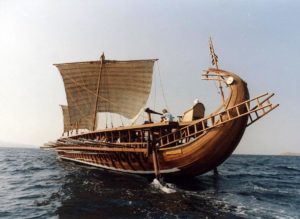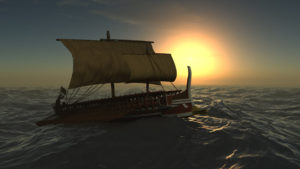Facts About First Boats And Warships
Although the discovery that wood or rattan floats on the water and can be driven undoubtedly very old, there are still only a few old boats preserved.
At Star Carr, in Yorkshire, a wooden paddle was discovered and the time of making it was estimated at 7500 BC. It has probably been used to launch canoes of the kind found in Pesse, Netherlands, built around the year 6300 before our era.
Such canoes made of tree trunks and carved with timeless tools can be large: one found in Brigg (Lincolnshire) is sixteen meters long and its deck has a cross-beam two meters long.
Egypt and Mesopotamia-built boats
 The ancient Egyptians and the inhabitants of Mesopotamia built their boats from the trestle plant, and served them to sail the canals and rivers.
The ancient Egyptians and the inhabitants of Mesopotamia built their boats from the trestle plant, and served them to sail the canals and rivers.
It is not, however, known when the first ships capable of sailing the sea were built. Vessels with sails have been used since about 3000 BC, so those, or boats with wooden caravans (and since the year 2000 BC, perhaps with a keel), had to be very important for trading nations in the eastern Mediterranean.
Pushing a boat with a wooden stick or a short paddle was undoubtedly the forerunner of a long owl, but these methods of transport were not satisfied, as the legendary Babylonian hero Gilgamesh discovered when he tried to cross over the ocean.
The legend says that on the river of death the sailor told him to make the wooden stick sixteen feet long, but even 120 such sticks connected to each other did not reach the bottom of river so that Gilgamesh split and lifted his hands instead of a mast and used wear as sailcloth.
Curragh or coracle
The other two types of boats, which did not use the idea of paddles, are very old, but have survived to this day: this is the Irish “curragh” or “coracle” – a box of wicked wicker covered with leather, then coated with tar; and more simpler boat of infested animal burial, depicted in the old reliefs, where it is used by the clever Assyrian soldiers to cross over the river and transfer their property.
Animal skins are used in the Middle East for the same purpose even today – as does a boat that has been operating on the Nile for five thousand years.
http://www.wildatlanticway.com/stories/coastal-escape/traditional-boats-guide/
First warships
 Two types of ships capable of sailing on the sea appeared at the time of old Greeks: a large, solid and bulky merchant ship and a much lighter warship that had, since the sixth century BC, had a long beak to pierce enemy ships on the bow.
Two types of ships capable of sailing on the sea appeared at the time of old Greeks: a large, solid and bulky merchant ship and a much lighter warship that had, since the sixth century BC, had a long beak to pierce enemy ships on the bow.
On these ships were sailors who, as soon as two ships were connected, fought on them as in a land battle. The tactics in the Mediterranean over two thousand years have not changed much.
The Battle of Lepanto in 1571 saw the naval forces of Spain, the Venetians and the papal states joined to defeat the Ottomans – it was the last decisive clash of rowing ships.
Long before Lepanto, the Vikings had fast warships. However, a newly developed ship with more masts and more decks, a heavily armed galleon, helped to bring the former supremacy of Mediterranean peoples to northwestern Europe, Spain and Portugal.

Comments are closed.